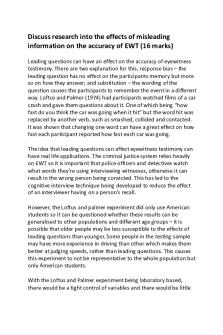Physiological Effects of Massage PDF

| Title | Physiological Effects of Massage |
|---|---|
| Course | Sports Therapy 1 |
| Institution | Edge Hill University |
| Pages | 8 |
| File Size | 122.9 KB |
| File Type | |
| Total Downloads | 71 |
| Total Views | 137 |
Summary
Download Physiological Effects of Massage PDF
Description
Week 9
Sports Therapy 1
Sports Therapy
Physiological Effects of Massage Structures and functions Cardiovascular system What are the structures involved? Heart, Blood Vessels (Capillaries, Arterioles, Veins, Arteries) and blood. What is the function of the system? To transport oxygen through the body. To remove metabolic waste such as CO2. To transport nutrients and hormones to cells. How does massage effect this system?
Improve circulation by mechanically assisting the venous flow of blood back to the heart. Dilate blood vessels helping them to work more efficiently. Produce an enhanced blood flow; delivery of fresh oxygen and nutrients to the tissues is improved and the removal of waste products, toxins and carbon dioxide is hastened via the venous system. Help temporarily to decrease blood pressure, due to dilation of capillaries. Decrease the heart rate due to relaxation. Reduce ischemia (ischemia is a reduction in the flow of blood to body parts, often marked by pain and tissue dysfunction).
Week 9
Sports Therapy 1
Sports Therapy
Respiratory What are the structure involved? Airways - Nose, Mouth, Trachea, larynx, Bronchi, Bronchioles & Lungs. Other – Diaphragm and Intercostal muscles What is the function of the system? Pulmonary Ventilation – Air moves in and out of the lungs to facilitate gas exchange Internal Respiration – Exchanges of gases, blood in capillaries and tissue to the body. External Respiration – Exchange of gases between air filling alveoli and the blood in the capillaries surrounding the wall of alveoli. How does massage effect this system?
Massage deepens respiration and improves lung capacity by relaxing any tightness in the respiratory muscles. It also slows down the rate of respiration due to the reduced stimulation of the sympathetic nervous system.
Week 9
Sports Therapy 1 Nervous System
What are the structures involved? CNS (Central Nervous System) – Brain and Spinal Cord. PNS (Peripheral Nervous System) – Cranial and Peripheral Nerves. Neurons – Sensory and Motor Neurons.. What is the function of this system? How does massage effect this system?
Sports Therapy
Week 9
Sports Therapy 1 Musculoskeletal System
What are the structures involved? What is the function of this system? How does massage effect this system?
Sports Therapy
Week 9
Sports Therapy 1 Digestive System
What are the structures involved? What is the function of this system? How does massage effect this system?
Sports Therapy
Week 9
Sports Therapy 1 Lymphatic System
What are the structures involved? What is the function of this system? How does massage effect this system?
Sports Therapy
Week 9
Sports Therapy 1 Urinary/Renal system
What are the structures involved? What is the function of this system? How does massage effect this system?
Sports Therapy
Week 9
Sports Therapy 1
Sports Therapy
Skin What are the structures involved? What is the function of this system? How does massage effect this system?
http://massagetherapy.co.uk/therapies-information/treatment-descriptions/benefits-effects-ofmassage/...
Similar Free PDFs

Physiological Effects of Massage
- 8 Pages

Integration of physiological systems
- 39 Pages

Integration of physiological systems
- 35 Pages

Quick massage
- 2 Pages

Sports Massage C - practise
- 1 Pages

PHYSIOLOGICAL PSYCHOLOGY
- 17 Pages

Salivary Glands Massage
- 1 Pages

THE EFFECTS OF CORRUPTION
- 5 Pages

Environmental Effects OF Quarrying
- 18 Pages

2... Effects OF Privation
- 2 Pages

Massage Full Body - notes
- 17 Pages

Legal effects of marriage
- 34 Pages

Massage treatment checklist
- 2 Pages
Popular Institutions
- Tinajero National High School - Annex
- Politeknik Caltex Riau
- Yokohama City University
- SGT University
- University of Al-Qadisiyah
- Divine Word College of Vigan
- Techniek College Rotterdam
- Universidade de Santiago
- Universiti Teknologi MARA Cawangan Johor Kampus Pasir Gudang
- Poltekkes Kemenkes Yogyakarta
- Baguio City National High School
- Colegio san marcos
- preparatoria uno
- Centro de Bachillerato Tecnológico Industrial y de Servicios No. 107
- Dalian Maritime University
- Quang Trung Secondary School
- Colegio Tecnológico en Informática
- Corporación Regional de Educación Superior
- Grupo CEDVA
- Dar Al Uloom University
- Centro de Estudios Preuniversitarios de la Universidad Nacional de Ingeniería
- 上智大学
- Aakash International School, Nuna Majara
- San Felipe Neri Catholic School
- Kang Chiao International School - New Taipei City
- Misamis Occidental National High School
- Institución Educativa Escuela Normal Juan Ladrilleros
- Kolehiyo ng Pantukan
- Batanes State College
- Instituto Continental
- Sekolah Menengah Kejuruan Kesehatan Kaltara (Tarakan)
- Colegio de La Inmaculada Concepcion - Cebu


